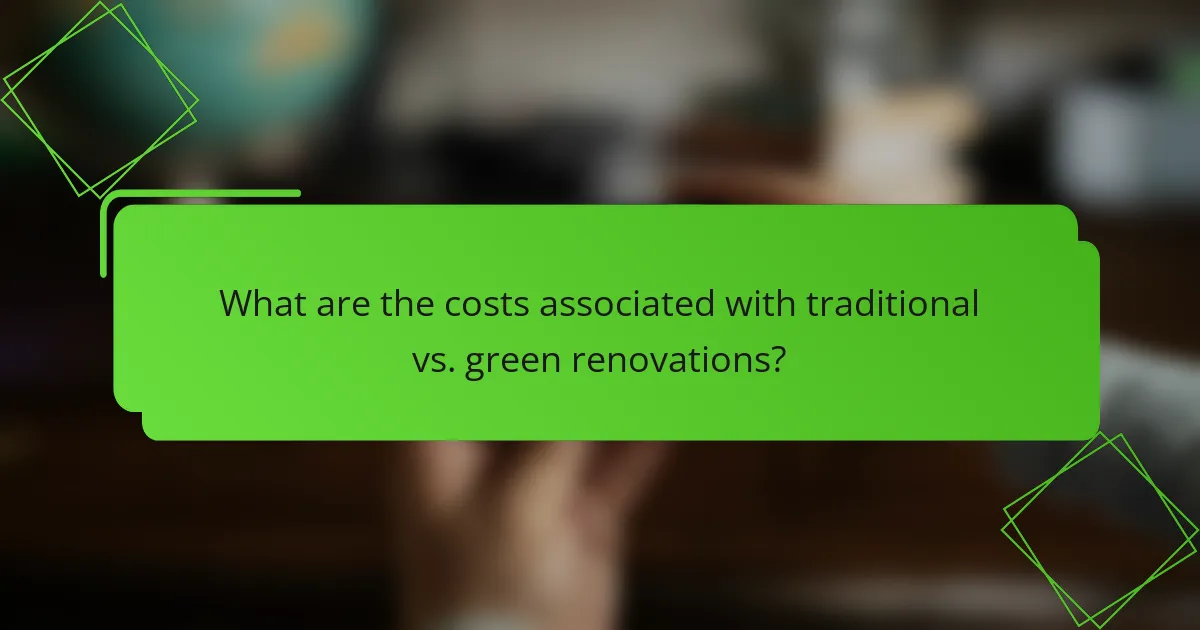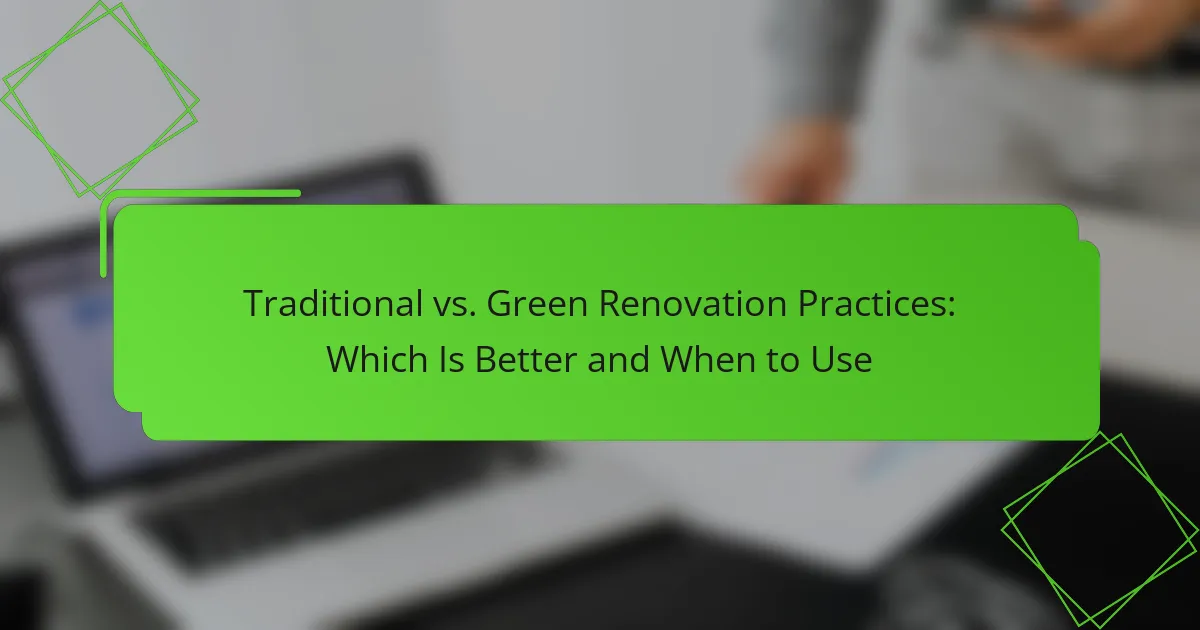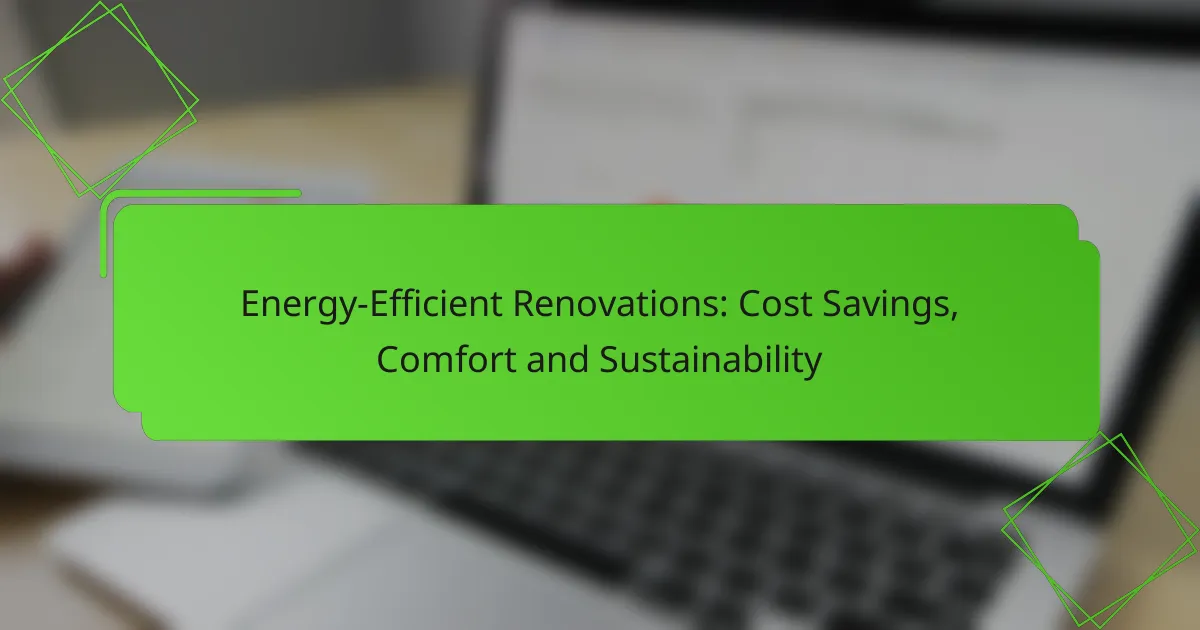When considering renovation options, homeowners often weigh the benefits of traditional practices against green alternatives. Traditional methods provide cost-effectiveness and familiarity, making them suitable for specific projects, especially with older structures. In contrast, green renovation practices emphasize sustainability and energy efficiency, offering long-term savings and environmental benefits. Understanding when to use each approach is essential for achieving the desired outcomes in any renovation project.

What are the benefits of traditional renovation practices in Ireland?
Traditional renovation practices in Ireland offer several advantages, including cost-effectiveness, established techniques, and readily available materials. These benefits make them a practical choice for many homeowners looking to improve their properties while staying within budget.
Cost-effectiveness
Traditional renovation practices are often more cost-effective than green alternatives. Homeowners can save on upfront costs by using conventional materials and methods, which typically have lower initial prices. This can be particularly beneficial for those working with limited budgets.
Additionally, traditional renovations may require less specialized labor, further reducing overall expenses. For example, local tradespeople are usually familiar with established techniques, which can lead to lower labor costs compared to hiring specialists for green renovations.
Established techniques
Established techniques in traditional renovations have been refined over many years, ensuring reliability and effectiveness. These methods are well-documented and understood, making it easier for homeowners to find skilled professionals who can execute the work competently.
Moreover, using tried-and-true methods can minimize risks associated with renovation projects. Homeowners can feel confident that these techniques have stood the test of time, resulting in durable and functional outcomes.
Availability of materials
The availability of materials for traditional renovations is generally high, making it easier for homeowners to source what they need. Common building materials such as bricks, timber, and plaster are widely accessible in Ireland, often at competitive prices.
In contrast, green renovation materials may not always be as readily available or may come at a premium. This can lead to delays in projects or increased costs, making traditional practices a more convenient option for many homeowners.

What are the benefits of green renovation practices in Ireland?
Green renovation practices in Ireland offer numerous advantages, including improved energy efficiency, reduced environmental impact, and potential long-term cost savings. These practices focus on using sustainable materials and technologies that benefit both homeowners and the planet.
Energy efficiency
Green renovation enhances energy efficiency by incorporating modern insulation techniques, energy-efficient windows, and renewable energy sources like solar panels. These upgrades can significantly reduce heating and cooling costs, often leading to savings of 20-30% on energy bills.
Homeowners should consider conducting an energy audit to identify areas for improvement. Simple measures, such as sealing drafts or upgrading to energy-efficient appliances, can yield immediate benefits.
Environmental sustainability
Environmental sustainability is a core principle of green renovation, focusing on minimizing waste and reducing carbon footprints. This can involve using reclaimed materials, low-VOC paints, and sustainable landscaping practices.
In Ireland, adhering to local environmental regulations and guidelines can further enhance sustainability efforts. For instance, choosing materials with certified sustainability labels can ensure that renovations contribute positively to the environment.
Long-term savings
Investing in green renovation can lead to significant long-term savings. While initial costs may be higher, the reduced energy consumption and lower maintenance needs often result in a return on investment within a few years.
Homeowners should evaluate the lifetime costs of materials and systems. For example, energy-efficient heating systems may have higher upfront costs but can save thousands in energy bills over their lifespan. Additionally, many local grants and incentives can help offset initial expenses, making green renovations more financially viable.

When should you choose traditional renovation practices?
Traditional renovation practices are often best suited for projects with specific constraints or requirements. These methods are typically more familiar to contractors and may be necessary for maintaining the integrity of older structures.
Budget constraints
When budget is a primary concern, traditional renovation practices can be more cost-effective. These methods often utilize readily available materials and established techniques, which can reduce labor costs and overall expenses. For instance, using standard drywall instead of eco-friendly alternatives may save several hundred dollars on materials alone.
It’s crucial to assess your financial limits and prioritize essential renovations. If you’re working with a tight budget, consider focusing on repairs that enhance safety and functionality before investing in green options that may have higher upfront costs.
Historical preservation
For properties with historical significance, traditional renovation practices are often required to comply with preservation standards. These methods help maintain the original character and architectural details of the building, which can be vital for heritage conservation. Local regulations may dictate specific materials and techniques that must be used to preserve the structure’s authenticity.
Engaging with local historical societies or preservation boards can provide guidance on necessary practices. Always ensure that any renovations respect the building’s history while meeting current safety standards.
Immediate needs
In situations where immediate repairs are necessary, traditional renovation practices can provide quicker solutions. For example, if a roof is leaking, using conventional materials and methods can expedite the repair process, allowing for immediate protection against further damage.
Evaluate the urgency of your renovation needs. If time is of the essence, prioritize traditional methods that can be implemented swiftly, while planning for more sustainable options in future renovations when time and resources allow.

When should you choose green renovation practices?
Green renovation practices should be chosen when sustainability, energy efficiency, and environmental impact are priorities for your project. These practices are particularly beneficial in situations where long-term savings and regulatory incentives can significantly enhance the value and performance of your property.
Long-term investment
Choosing green renovation practices often leads to long-term financial benefits. While the initial costs may be higher, energy-efficient materials and systems can reduce utility bills significantly over time, sometimes by 20-50%. Additionally, properties that incorporate sustainable features tend to have higher resale values.
Consider investing in high-quality insulation, energy-efficient windows, and renewable energy sources like solar panels. These upgrades not only improve comfort but also contribute to substantial savings in the long run.
Regulatory incentives
Many local and national governments offer incentives for green renovations, including tax credits, rebates, and grants. These financial benefits can offset initial costs and make green practices more accessible. Check with local authorities to understand what incentives are available in your area.
For instance, in the United States, the Energy Policy Act provides tax deductions for energy-efficient improvements. In Europe, various countries have their own programs that encourage sustainable building practices, often linked to the EU’s Green Deal initiatives.
Environmental impact concerns
Green renovation practices directly address environmental concerns by reducing waste, lowering carbon footprints, and conserving natural resources. Using sustainable materials and energy-efficient systems helps mitigate the negative impacts of construction and renovation on the environment.
For example, opting for recycled materials or sustainably sourced wood can significantly lessen the ecological footprint of your renovation. Additionally, implementing water-saving fixtures and energy-efficient appliances contributes to overall sustainability, making your property more environmentally friendly.

What are the costs associated with traditional vs. green renovations?
The costs of traditional and green renovations can vary significantly based on materials, labor, and long-term savings. Traditional renovations often have lower upfront costs, while green renovations may be higher initially but can lead to savings over time through energy efficiency and sustainability.
Average costs for traditional renovations
Traditional renovations typically range from low tens of thousands to over a hundred thousand USD, depending on the scope of the project. Basic updates like painting or flooring can cost a few thousand dollars, while major renovations, such as kitchen or bathroom remodels, can reach upwards of 50,000 USD.
Labor costs also play a significant role, often accounting for 20-35% of the total renovation budget. Homeowners should budget for unexpected expenses, which can arise during the renovation process.
Average costs for green renovations
Green renovations generally have higher initial costs, often ranging from 10-30% more than traditional renovations. For example, energy-efficient windows or sustainable materials can significantly increase upfront expenses, sometimes adding thousands to the total cost.
However, these investments can lead to long-term savings through reduced energy bills and potential tax incentives. Homeowners should consider the return on investment when evaluating green options, as many eco-friendly upgrades can pay off within a few years.



